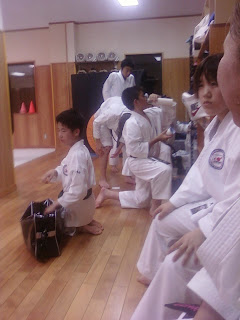 Among the many things I'm getting used to during my year here is the dojo culture. Although I've been told every dojo has it's own culture based on the style of karate and the desires of the dojo's Sensei/instructors, Shiramizu is the only dojo I've ever spent a significant amount of time in. Therefore, my observations are based on that, plus the fact that I'm a beginner.
Among the many things I'm getting used to during my year here is the dojo culture. Although I've been told every dojo has it's own culture based on the style of karate and the desires of the dojo's Sensei/instructors, Shiramizu is the only dojo I've ever spent a significant amount of time in. Therefore, my observations are based on that, plus the fact that I'm a beginner.Thus, for other beginners like myself, this blog in no way should be considered universally representative of all karate dojos, all dojos in Japan, or even Shiramizu, as I am approaching it from a beginner's and a foreigner's standpoint. I am simply trying to relay my experience and, should another Karate beginner choose to apply for the internship, they can get a sense of Shiramizu.
There are some things that even a month later I am still trying to make habitual. They are small things, but I feel that when I miss them, it's another way, on top of everything else, that I can be seen as being a beginner and a bit of an outsider. Some of these things include:
• When entering the dojo, everyone says "お願いします/Onegaishimasu" and takes off their shoes, and the other members will respond in kind by saying "お願いします/Onegaishmasu". I will sometimes forget this greeting both when I enter and when others enter the dojo.
• While stretching together, whenever the stretch or warm up changes (for example, changing from running to skipping, or stretching the right leg to the left) everyone says "Hai!" but I often forget to do it until about halfway into the warm up.
• During sparring people say "Fighto!" and other expressions as a way to encourage everyone. I'm still trying to pick up on all of them.
• When drinking water during a break, you are supposed to sit down. I didn't know this until Peter told me. As a former long distance runner, I'm definitely used to standing up and drinking quickly so I've made this mistake often.
(Richard here - I've never thought about sitting down on water breaks, but for eating something substantial, sitting down is culturally correct).
• There are various times (such as the beginning and end of practice, as well as getting ready to practice kihon) that we line up accruing to belt color/experience. Even now, I am never quite sure when I should line up and I looked to one of the Sensei's for confirmation.
• Another interesting thing that I've noticed and struggled with is the notion of making a face of confusion. In America, with every sport that I've ever done, when something was difficult or confusing the participants would usually make some kind of pained expression to nonverbal signal to the instructor our lack of understanding so that they would come and help us out. Of course, come performance time or a competition, you would hide that the best you could. I could be wrong, but it seems that in the dojo, simply doing things incorrectly is enough of a signal in and of itself, as the instructors pay very close attention to the students.
Here, it seems better to look serious and thoughtful even during times of difficulty. Of course, the amount of times when everyone else is confused as opposed to myself is so uneven that maybe I haven't had enough experience to speak to that as of yet.
However, the one thing I can do without a hitch is cleaning! :)
We vacuum, sweep and wipe down the dojo after we finish practicing.
 One non-cultural difficulty about being a beginner is that I am usually regulated to practicing with one of the Sensei. This is great in the sense that they are the best resources available to help me improve my kihon, and I also know they are experienced enough that my clumsiness doesn't inadvertently harm them. On the other hand, I rarely have any interaction with other members of the dojo, so it's hard for me to socialize despite having conversational Japanese ability. However, maybe in a few months time I'll be able to join the others occasionally.
One non-cultural difficulty about being a beginner is that I am usually regulated to practicing with one of the Sensei. This is great in the sense that they are the best resources available to help me improve my kihon, and I also know they are experienced enough that my clumsiness doesn't inadvertently harm them. On the other hand, I rarely have any interaction with other members of the dojo, so it's hard for me to socialize despite having conversational Japanese ability. However, maybe in a few months time I'll be able to join the others occasionally.There are a host of other small things that I could speak to, but the blog would get much too long. Soon I will finish my first full month here, so hopefully I will feel more comfortable. Until then, I will continue to observe and do the best I can.
